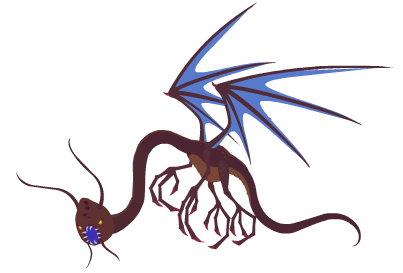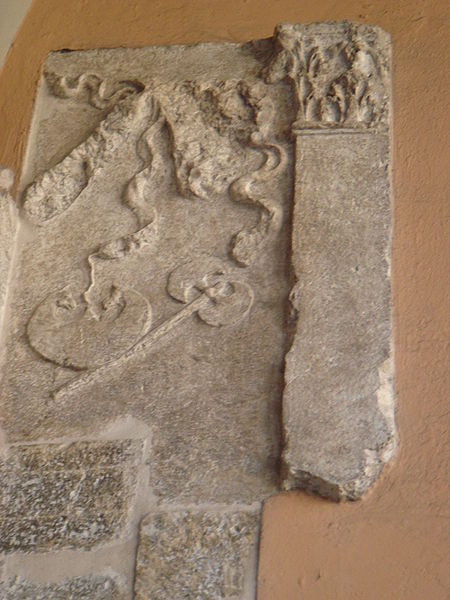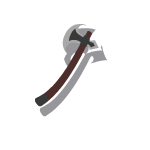Hi Folks!
Welcome to the another edition of the Did You Know series! This week Jabberwocky will be my feature. You may not heard of it yet, because it’s a monster from Ancient City of Lost Mythos (Magical Rooms Premium Lobby). I found some information about this creature, i hope you enjoy it! 😀 😀 😀

“‘Jabberwocky’ is a poem of nonsense verse written by Lewis Carroll, originally featured as a part of his novel Through the Looking-Glass, and What Alice Found There (1872). The book tells of Alice’s travels within the back-to-front world through a looking glass.
While talking with the White King and White Queen (chess pieces), she finds a book written in a strange language that she can’t read. Understanding that she is travelling in an inverted world, she sees it is mirror-writing. She finds a mirror and holds it up to a poem on one of the pages, to read out the reflection of ‘Jabberwocky’. She finds it as puzzling as the odd land she has walked into, which we later discover is a dreamscape.
It is considered to be one of the greatest nonsense poems written in the English language. The playful, whimsical poem became a source of nonsense words and neologisms such as “galumphing”, “chortle”, and “Jabberwocky” itself.
Jabberwocky
‘Twas brillig, and the slithy toves
Did gyre and gimble in the wabe;
All mimsy were the borogoves,
And the mome raths outgrabe.
“Beware the Jabberwock, my son!
The jaws that bite, the claws that catch!
Beware the Jubjub bird, and shun
The frumious Bandersnatch!”
He took his vorpal sword in hand:
Long time the manxome foe he sought–
So rested he by the Tumtum tree,
And stood awhile in thought.
And as in uffish thought he stood,
The Jabberwock, with eyes of flame,
Came whiffling through the tulgey wood,
And burbled as it came!
One, two! One, two! and through and through
The vorpal blade went snicker-snack!
He left it dead, and with its head
He went galumphing back.
“And hast thou slain the Jabberwock?
Come to my arms, my beamish boy!
O frabjous day! Callooh! Callay!”
He chortled in his joy.
‘Twas brillig, and the slithy toves
Did gyre and gimble in the wabe;
All mimsy were the borogoves,
And the mome raths outgrabe.”
 ‘Jabberwocky’ has been translated into many languages. The task of translation is more notable and difficult because the poems hold to English syntax and many of the principal words of the poem are created nonce words that had no previous meaning. Translators have generally dealt with these words by inventing words of their own. Often these are similar in spelling or sound to Carroll’s words while respecting the morphology of the language to be translated into. For example in Frank L. Warrin’s French translation “‘Twas brillig” is translated as “Il brilgue”. In cases like this, both the original and the invented words echo actual words in Carroll’s lexicon, but not necessarily ones with similar meanings. Translators have also invented words which draw on root words with meanings similar to the English roots used by Carroll. For example Douglas Hofstadter noted in his essay “Translations of Jabberwocky”, the word ‘slithy’ echoes English words including ‘slimy’, ‘slither’, ‘slippery’, ‘lithe’ and ‘sly’. A French translation that uses ‘lubricilleux’ for ‘slithy’, evokes French words like ‘lubrifier’ (to lubricate) in order to give an impression of a meaning similar to that of Carroll’s word. In his exploration of the translation challenge, Hofstadter asks “what if a word does exist, but it is very intellectual-sounding and Latinate (‘lubricilleux’), rather than earthy and Anglo-Saxon (‘slithy’)? Perhaps ‘huilasse’ would be better than ‘lubricilleux’? Or does the Latin origin of the word ‘lubricilleux’ not make itself felt to a speaker of French in the way that it would if it were an English word (‘lubricilious’, perhaps)? “.
‘Jabberwocky’ has been translated into many languages. The task of translation is more notable and difficult because the poems hold to English syntax and many of the principal words of the poem are created nonce words that had no previous meaning. Translators have generally dealt with these words by inventing words of their own. Often these are similar in spelling or sound to Carroll’s words while respecting the morphology of the language to be translated into. For example in Frank L. Warrin’s French translation “‘Twas brillig” is translated as “Il brilgue”. In cases like this, both the original and the invented words echo actual words in Carroll’s lexicon, but not necessarily ones with similar meanings. Translators have also invented words which draw on root words with meanings similar to the English roots used by Carroll. For example Douglas Hofstadter noted in his essay “Translations of Jabberwocky”, the word ‘slithy’ echoes English words including ‘slimy’, ‘slither’, ‘slippery’, ‘lithe’ and ‘sly’. A French translation that uses ‘lubricilleux’ for ‘slithy’, evokes French words like ‘lubrifier’ (to lubricate) in order to give an impression of a meaning similar to that of Carroll’s word. In his exploration of the translation challenge, Hofstadter asks “what if a word does exist, but it is very intellectual-sounding and Latinate (‘lubricilleux’), rather than earthy and Anglo-Saxon (‘slithy’)? Perhaps ‘huilasse’ would be better than ‘lubricilleux’? Or does the Latin origin of the word ‘lubricilleux’ not make itself felt to a speaker of French in the way that it would if it were an English word (‘lubricilious’, perhaps)? “.
Hofstadter also notes that it makes a great difference whether the poem is translated in isolation or as part of a translation of the novel. In the latter case the translator must, through Humpty Dumpty, supply explanations of the invented words. But, he suggests, “even in this pathologically difficult case of translation, there seems to be some rough equivalence obtainable, a kind of rough isomorphism, partly global, partly local, between the brains of all the readers”.
In 1967, D.G. Orlovskaya wrote a Russian translation of “Jabberwocky” entitled “Barmaglot” (“Бармаглот”), which became popular for its nonsensical rhymes. “Barmaglot” becomes the word for the “Jabberwock”, “Brandashmyg” for “Bandersnatch” and words like “myumsiki” (“мюмзики”) echo “mimsy”. Yuen Ren Chao, a Chinese linguist, translated the poem into Chinese by inventing characters to imitate what Rob Gifford of National Public Radio refers to as the “slithy toves that gyred and gimbled in the wabe of Carroll’s original”. Satyajit Ray, a film-maker, translated the work into Bengali[30] and concrete poet Augusto de Campos created a Brazilian Portuguese version. There is also an Arabic translation by Wael Al-Mahdi and multiple translations into Latin were made within the first weeks of Carroll’s original publication”
It was very exciting for me to prepare this edition of Did You Know series, i’ve enjoyed it a lot. I hope you did as well. Thank you for reading, take care and see you!! 😀 😀
 “The axe, or ax, is an implement that has been used for millennia to shape, split and cut wood; to harvest timber; as a weapon; and as a ceremonial or heraldic symbol. The axe has many forms and specialized uses but generally consists of an axe head with a handle, or helve.
“The axe, or ax, is an implement that has been used for millennia to shape, split and cut wood; to harvest timber; as a weapon; and as a ceremonial or heraldic symbol. The axe has many forms and specialized uses but generally consists of an axe head with a handle, or helve.





















